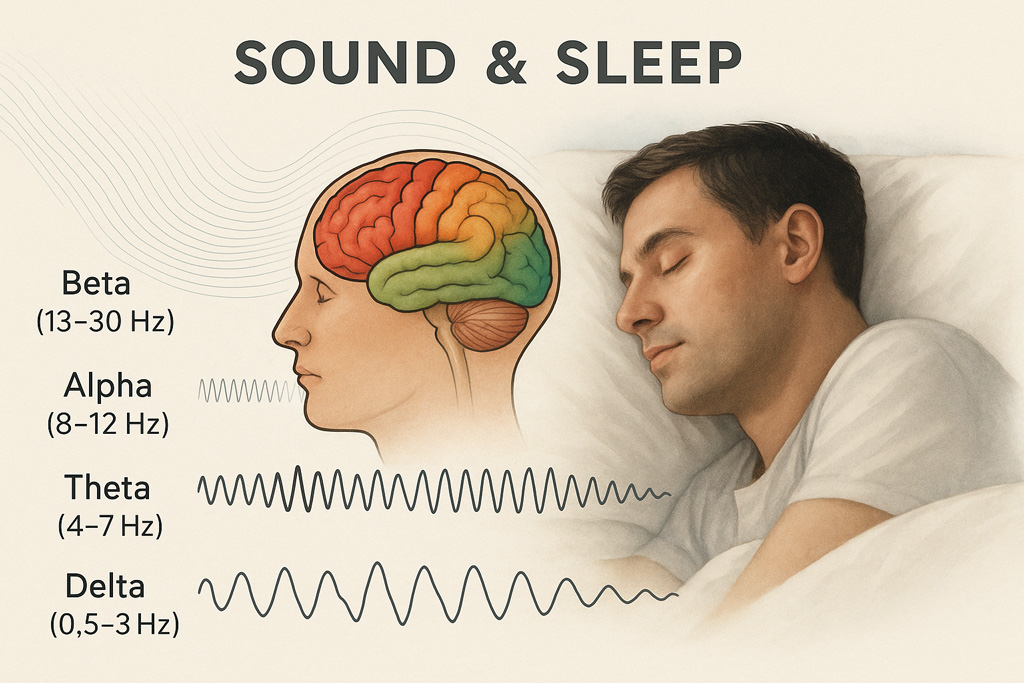Sound & Sleep: The Science of Restorative Vibration
Introduction
Sleep is one of the body’s most vital healing mechanisms. Without sufficient restorative rest, our physical health, emotional stability, and cognitive performance decline. While many factors influence sleep, sound is among the most powerful—and often overlooked—tools for improving sleep quality. From scientific research on brainwave entrainment to ancient traditions of sound healing, the evidence shows that sound and vibration can guide the body into deeper states of rest.

The Science of Sound and Sleep
1. Brainwave Entrainment
Our brain naturally produces different waves depending on our state of consciousness.
- Beta waves (13–30 Hz) dominate when we are awake and alert.
- Alpha waves (8–12 Hz) are linked to relaxation.
- Theta waves (4–7 Hz) occur in light sleep and deep meditation.
- Delta waves (0.5–3 Hz) are the hallmark of deep, restorative sleep.
Research shows that rhythmic sound—such as binaural beats, steady drumming, or harmonic tones—can gently synchronize the brain into slower rhythms, encouraging the transition from wakefulness to sleep.
2. The Role of Frequency and Vibration
Low-frequency sounds have a soothing effect on the nervous system, slowing down heart rate and activating the parasympathetic “rest and digest” response. Vibrations from instruments like gongs, singing bowls, or tuning forks don’t just affect the ears—they resonate through the body’s tissues, supporting relaxation on a cellular level.
3. Sound, Hormones, and Circadian Rhythm
Cortisol, the stress hormone, is a major disruptor of sleep. Studies suggest that calming sounds lower cortisol levels and increase melatonin production, aligning the body’s natural circadian rhythm. This makes sound a non-invasive, side-effect-free method of supporting hormonal balance for better sleep.
Practical Sound-Based Techniques for Better Sleep
1. Pre-Sleep Sound Rituals
Listening to 20–30 minutes of calming music or soundscapes before bed helps signal the body to wind down. Choose slow, steady rhythms (60–80 beats per minute) to mimic the resting heart rate.
2. Binaural Beats and Isochronic Tones
These audio technologies use specific frequencies to guide the brain toward theta and delta states. For example, a 4 Hz binaural beat encourages theta activity, supporting relaxation and entry into sleep.
3. Singing Bowls and Gongs
A short sound bath before bed creates an immersive field of vibration. The harmonic overtones quiet the mind and release muscular tension, making it easier to drift into sleep.
4. Voice and Breath
Gentle humming or chanting on the exhale lengthens the breath, activates the vagus nerve, and calms the nervous system. This practice bridges sound healing with breathwork for powerful relaxation.
5. Natural Soundscapes
Rain, ocean waves, or forest recordings are proven to reduce the sympathetic “fight or flight” response. Integrating these sounds as white noise helps mask disruptive environmental noise.
Benefits of Sound for Sleep Health
- Improved sleep onset: Falling asleep faster.
- Deeper sleep cycles: More time in delta-wave sleep, crucial for repair and memory consolidation.
- Reduced anxiety and stress: Calmer mind before and during sleep.
- Non-pharmacological solution: Avoids dependence on sleeping pills.
- Enhanced overall wellbeing: Better sleep translates into sharper focus, improved mood, and stronger immunity.
Conclusion
Sound is more than an external experience—it is a direct pathway to the nervous system and brain. By harnessing the right frequencies and vibrations, we can create an environment that supports sleep on a physiological and emotional level. From scientific evidence to ancient healing traditions, sound emerges as a natural, accessible tool for anyone seeking deeper rest.
Integrating sound into your evening routine may be one of the simplest yet most profound steps toward better health, balance, and vitality.
